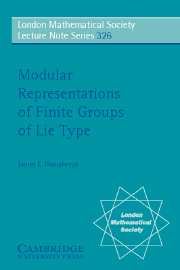Book contents
- Frontmatter
- Contents
- Preface
- 1 Finite Groups of Lie Type
- 2 Simple Modules
- 3 Weyl Modules and Lusztig's Conjecture
- 4 Computation of Weight Multiplicities
- 5 Other Aspects of Simple Modules
- 6 Tensor Products
- 7 BN-Pairs and Induced Modules
- 8 Blocks
- 9 Projective Modules
- 10 Comparison with Frobenius Kernels
- 11 Cartan Invariants
- 12 Extensions of Simple Modules
- 13 Loewy Series
- 14 Cohomology
- 15 Complexity and Support Varieties
- 16 Ordinary and Modular Representations
- 17 Deligne–Lusztig Characters
- 18 The Groups G2(q)
- 19 General and Special Linear Groups
- 20 Suzuki and Ree Groups
- Bibliography
- Frequently Used Symbols
- Index
4 - Computation of Weight Multiplicities
Published online by Cambridge University Press: 23 November 2009
- Frontmatter
- Contents
- Preface
- 1 Finite Groups of Lie Type
- 2 Simple Modules
- 3 Weyl Modules and Lusztig's Conjecture
- 4 Computation of Weight Multiplicities
- 5 Other Aspects of Simple Modules
- 6 Tensor Products
- 7 BN-Pairs and Induced Modules
- 8 Blocks
- 9 Projective Modules
- 10 Comparison with Frobenius Kernels
- 11 Cartan Invariants
- 12 Extensions of Simple Modules
- 13 Loewy Series
- 14 Cohomology
- 15 Complexity and Support Varieties
- 16 Ordinary and Modular Representations
- 17 Deligne–Lusztig Characters
- 18 The Groups G2(q)
- 19 General and Special Linear Groups
- 20 Suzuki and Ree Groups
- Bibliography
- Frequently Used Symbols
- Index
Summary
In principle the classical results of Curtis and Steinberg (Chapter 2) reduce the study of simple KG-modules for a finite group G of Lie type in the defining characteristic to the study of simple G-modules L(λ) with p-restricted highest weights. But the comparison with Weyl modules in Chapter 3 indicates that it is important in practice to allow more general highest weights.
For the relevant weights and primes, Lusztig's Conjecture promises what is probably the best possible conceptual understanding of the characters of simple modules for G. It explains for example the sense in which their behavior is controlled by the affine Weyl group, independent of p. But from the combinatorial viewpoint, the recursive calculations needed to determine ch L(λ) explicitly remain daunting.
Since the early 1970s some effective computational approaches have been developed, based on the possibility of working with Weyl modules over ℤ: see 4.2 and 4.4. Here too there is a recursive flavor, similar to that involved in Lusztig's approach to character formulas, but there is no special requirement on p. As a result, many explicit results for relatively small highest weights have been obtained with the help of computers. In this chapter we explain the basic methods involved and survey what has actually been done. One byproduct of the computational work is a good understanding of “small” representations for each of the simple types (4.7).
- Type
- Chapter
- Information
- Modular Representations of Finite Groups of Lie Type , pp. 33 - 40Publisher: Cambridge University PressPrint publication year: 2005



